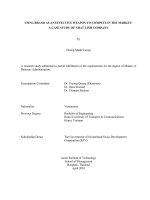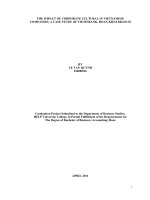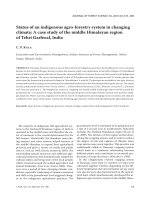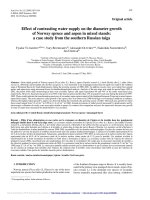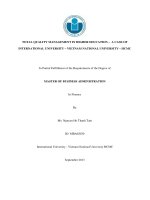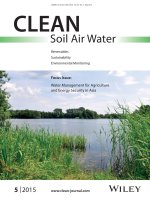TOURISM MANAGEMENT IN VIETNAM HOIAN, A CASE STUDY - Full 10 điểm
Bạn đang xem bản rút gọn của tài liệu. Xem và tải ngay bản đầy đủ của tài liệu tại đây (3.69 MB, 149 trang )
TOURISM MANAGEMENT IN VIETNAM
HOIAN, A CASE STUDY
HANNAH PHAN NHU NGOC HAN
(B.A, VN)
A THESIS SUBMITTED
FOR THE DEGREE OF MASTER OF ARTS
SOUTHEAST ASIAN STUDIES PROGRAMME
NATIONAL UNIVERSITY OF SINGAPORE
2004
ACKNOWLEDGEMENTS
I would like to begin this grateful acknowledgement with a thank you note to
my supervisor. I am deeply indebted to him, Associate Professor John N. Miksic, who
guided me ever since the beginning of this research. He has always given me his
support, encouragement and empathy. I would like to take this opportunity to thank
him for his kindness, concern, understanding and patience when my research speed
was so slow. I’m also thankful for Mrs. Heimun Miksic for her encouragements during
my course.
Secondly, I would like to thank the National University of Singapore for giving
me the chance of pursuing my research with a Research Scholarship, without which I
would not have been able to complete my study.
Thirdly I would like to extend my gratitude to the staff of the Southeast Asian
Studies Programme, who have become my good friends after almost 3 years,
especially Lucy Tan, Rohani J., and Rohani S. for their humour and willingness to help
whenever I come and disturb them with my endless questions.
I am also grateful for the help and guidance of Dr. Bruce Lockhart, who speaks
such good Vietnamese that I sometimes had to ask him how to put my thoughts into
words; Professor Chua Beng Huat, Dr. Goh Beng Lan for encouraging me through my
study; Mr. and Mrs. Kwa Chong Guan who have always taken an interest in the
progress of my work – making me guilty enough to continue my quest.
Without the help and assistance of the local people and tourists - who have now
become dear friends – whom I met during my field trips in Hoian, I would not have
been able to finish this thesis. Many thanks to Mr. Nguyen Su, the Chairman of the
Hoian’s People’s Committee for granting me more than 1 interview; to Mr. Vo Phung,
Director of Hoian Centre for Culture and Sports; Mr. Tran Anh, Director of Hoian
i
Centre for Monuments Management and Preservation; Ms. Thu, Director of Hoian
Hotel; to Ms. Bich Lan and her husband, chi Hien, Vu Trong Nhan and many other
local Hoianese and tourists I met during my stays there. I will always remember how
warm and welcomed I felt when I was in Hoian.
I would like to thank my partner, Anthony, for everything he did for me:
proofreading, consolidating data, going on field trips and so on. He has been my
unofficial secondary supervisor at home and has shared the family’s financial burden
for the 3 years I have been in the graduate studies programme. Thank you.
Finally, I would like to express my deepest appreciation to these two special
people in my life. I am deeply grateful to my parents whom I love dearly. They always
provide the best for me and have always wanted to see me completing my study to the
best of my ability. Without them, I would not be where I am today. Ba me, thank you. I
love you.
ii
TABLE OF CONTENTS
Acknowledgements Page
Table of Contents i
Summary iii
Chapter 1: Introduction v
1
INTRODUCTION 1
AIMS AND OBJECTIVES 5
CONCEPTUAL FRAMEWORK AND LITERATURE REVIEW 11
RESEARCH METHODOLOGY 20
Chapter 2: Historical Background of Hoian 25
Chapter 3: A Closer Look into Hoian’s Current Physical 40
and Social Conditions 40
40
A. HOIAN’S PHYSICAL SITUATION 44
57
1. Before 1985 57
58
2. From 1985 until now
67
B. LIFESTYLES OF HOIANESE 67
74
1. Before 1990 81
105
2. After 1990
iii
Chapter 4: Cultural Resource Management in Hoian
with regard to Tourists and Locals
A. TOURISTS’ OPINIONS
B. HOIANESE’S PERCEPTIONS
C. THE AUTHORITIES’ OPINIONS
Chapter 5: Conclusion
A. SUMMARY OF DATA 105
B. HOIAN AS A CASE STUDY FOR OTHER HISTORICAL SITES IN VIETNAM 116
C. POSSIBLE FUTURE OUTCOMES OF HOIAN 118
D. SOLUTIONS TO POSSIBLE PROBLEMS. 122
E. SUSTAINABLE TOURISM IN HOIAN 125
Bibliography 129
Appendix 1: General Questions for Interviews
Appendix 2: Pictures of Hoian
iv
SUMMARY
Hoian has always been on the top list of tourists’ favourite destinations in
Vietnam. It was a renowned international trading port set up late in the 16th century. It
is the only place in Vietnam to have many of its original streets and architectures
preserved intact, typical of an old seaport town in Southeast Asia.
With its rich culture and the great potential for tourism, in 1999, Hoian was
honourably inscribed by UNESCO for “being an exceptionally well preserved example
of a South East Asian trading port from the period of the 15th to 19th centuries”.
This thesis will examine the important role that tourism management plays in
the preservation of cultural monuments in the face of growing cultural tourism
Although Hoian is 'exposed' to the world (i.e. listed by UNESCO) for only a few years,
it has already implemented policies to balance the influx of tourists against the needs
to preserve its cultural heritage. This would suggest the presence of good tourism
management practices is vital to achieving success in addressing the sometimes-
conflicting needs of tourism and preservation. In addition, it would also suggest that
the attitudes of the local people and government play an important role in making this
possible.
v
CHAPTER 1
INTRODUCTION
Sustainable tourism has its roots in the concept of sustainable development
generally, defined by the Brundtland Commission as “development that meets the
needs of the present without compromising the ability of future generations to meet
their own needs”.1 Since then it has been adopted and applied in a wide range of
human contexts, in an attempt to address simultaneously both developmental and
environmental imperatives. The common question is: can tourism grow in a
sustainable manner? This is not to say that sustainable tourism has been the experience
on the world scene to date. Any number of examples can be quoted of the expansion of
tourism in a fashion which is clearly unsustainable, especially in the developing
countries. For the tourism sector, the concept of sustainability implies meeting current
uses and demands of tourism without impairing the natural and cultural heritage, or
opportunities for collective enjoyment of tourists of the future.2 This is a study of the
concept of “sustainable tourism” in the Vietnamese context.
There have been comprehensive studies from neighbouring countries that
measure the economic impact of tourism and its linkages to other sectors in the
economy. Bali, Singapore, and Thailand offer three examples which can be used to
create analogies with Vietnam.
In Bali, the locals are able to have economic resources to preserve their local
dances and traditions because the tourists travel long distances just to appreciate
Balinese culture. Without cultural tourism, Bali would have to rely on other forms of
development which would generate a much higher rate of negative effects on the local
1 World Commission on Environment and Development, Our Common Future, Oxford, Oxford
University Press, 1987, p. 4.
2 Hawkes, S. and Williams, P., The Greening of Tourism, Burnaby BC: Simon Fraser University, Centre
for Tourism and Policy Research, 1993.
1
culture, and the local customs, architecture, clothing, food, and other kinds of
businesses would have given way to more competitive global brands. Some worry that
Bali has become too touristic and the traditional cultures are showing signs of
touristification – that is, the culture is being altered to suit the expectation of tourists.
Others believe that Bali is one of the more successful examples of incorporation of
tourism into a culture’s total adaptation to the environment.3
Bugis Street, Singapore 4 originally was a cultural landscape filled with
tradition, glitter and a chaotic atmosphere of enjoyment, eating and shopping. In the
1980s the Singapore government authorities wanted to integrate the old ways with
modernity, while eliminating what some perceived as the less desirable traditional
aspects of the area such as common displays of transvestitism. They also sought to
revitalise the traditional activities and communal activities in the area. They set up a
service infrastructure to ensure hygiene standards were kept, and food prepared by the
hawkers was of high standards. Shop-houses were replicated and given a weathered
look to make them look more authentic. The night market was retained. However, the
efforts failed to perpetuate the atmosphere which attracted tourists. Activities were too
planned and coordinated and the chaotic atmosphere which was the charm of Bugis
Street all disappeared only to be replaced by strict laws and regulations. It was the
perfect example of how physical infrastructure may be reconstructed but relationships
and social interactions cannot be so easily engineered. The management of Bugis then
decided to bring back the infamous transvestites.
However, this was met with heavy resistance by other members of the public in
favour of morality. The government also refused to budge an inch. Singapore was
3 Picard, M. "Cultural Tourism in Bali: The Construction of a Cultural Heritage." In Wiendu Nuryanti,
ed. Tourism and Heritage Management. Yogyakarta: Gadjah Mada University Press, 1997, p. 147-164.
4 Kuah Khun Eng. "Bugis Street in Singapore: Development, Conservation and the Re-invention of
Cultural Landscape." In M. Askew and W.S. Logan, eds. Cultural Identity and Urban Changes in
Southeast Asia: Interpretative Essays. Victoria: Deakin University Press, 1994, p. 167-186.
2
marketed as a clean and moral society and the government refused to consider the
deviant lifestyle as a highlight of any of its tourist spots. Today, Bugis is only
beginning to be frequented by the locals. The whole area is now focusing on new
social activities and highlighting its night market as bohemian. The younger
generations are experimenting with setting up their own retail business in the night
market and the new shopping centre. Although the traditional buildings still stand, the
Bugis area is undergoing social changes.
In the case study of Singapore's Bugis Street, the government defined heritage
conservation as the preservation of architecture and ambience. Conservation plans
involved the improvement of the physical environment in the areas of walkways,
landscaping and hygiene standard of the area. Lastly, conservation included the
enhancement of the character of the area. This could be in the form of introducing new
activities while sustaining the old traditional activities of touristic value.
The Singapore policy in conserving an area also requires the active efforts of
the private sector. Some, however, have argued that Singapore concentrates too
heavily on buildings while neglecting culture. This has been asserted in the case of
Chinatown for instance. 5
Shophouses are the primary feature of Chinatown’s landscape and Chinatown’s
value lies in the shophouses’ contribution to the larger urban texture. The shophouse is
essentially a pre-industrial urban unit and a characteristic building type of 19th and
early 20th century Southeast Asian towns, cities and commercial centres. Residents
were ‘re-located’ outside the ‘traditional’ Singapore Chinatown in order for the
authorities to recreate the unique ‘Chinatown’ experience.6 Sites like People’s Park
5 Historic districts in the Central area : a manual for Chinatown conservation area. Singapore : Urban
Redevelopment Authority , 1988
6 Kwok, Wee and Chia, eds. Rethinking Chinatown and Heritage Conservation in Singapore.
Singapore: Singapore Heritage Society, 2000.
3
Complex, Thong Chai Medical Hall and Yung Cheng School were not included in the
Singapore Tourism Board’s plans. These places were milestones in the development
of early Chinese migrant society and People’s Park contains old businesses like watch-
repairing, selling of textiles, hardware shops. Thus with just the buildings conserved
and not the activities and businesses, Chinatown lost its vibrancy and became a
‘soulless’ place.
Chiang Mai, Thailand7 faced a real estate boom in the 1980s due to tourism.
Hotels and condominiums were built to support the migration of people into the area.
However, this development had negative effects on heritage conservation as residents
from Bangkok and foreigners from China and Japan made their way to Chiang Mai.
The Bangkok residents bought up the properties for investment while the Chinese and
Japanese needed accommodation for business stays and also for property speculation.
This inflow of investment did not benefit the Chiang Mai residents at all. They were
pushed out of their homes and into the outskirts. The traditional way of life has given
way to speculative investment in construction. Heavier traffic resulted in air and noise
pollution. City dwellers switched to motorbikes to avoid traffic jams. This made the
noise pollution more intolerable.
The new habitats also brought other social problems. The peace and serenity of
Chiang Mai seemed more evasive. To add more problems, household refuse and liquid
wastes were emptied into the nearby Ping River. It was only as recent as 1990 that the
local authorities took a firm stand against the further degeneration of Chiang Mai. A
council was set up to find solutions for ending investors’ harmful activities. They
sought to slow down development of new construction, took measures to preserve
7 Lubeigt, Guy. "Traditional and Recent Aspects of the Urban Development of Chiang Mai, Thailand."
in M. Askew and W.S. Logan, eds. Cultural Identity and Urban Change in Southeast Asia:
Interpretative Essays. Geelong: Deakin University Press, 1994; p. 117-134.
4
tourist sites and protect the composition of the region. Strategies included prohibiting
buildings more than sixteen stories within a hundred meters of the monasteries.
Buildings of more than twelve stories were disallowed on the banks of the river. The
authorities also began the restoration of traditional houses. There was also a revival of
the traditional wood trade and the maintenance of ancient techniques. These were also
sustained by the growing interest of tourists in antiques and old dwellings. The
preservation of the old traditional ways would not have been successful if it were not
for the market demand for these products.
Chiang Mai's case study is a perfect example of how tourism can encourage
and sustain a traditional way of life. However, the renewal of craft activities may be
superficial. The industry of Chiang Mai may change with the winds of fortune. In
other words, it is not yet possible to conclude that Chiang Mai’s model of development
will be culturally sustainable. Whatever our conclusions, Chiang Mai's new
development in tourism has forced its inhabitants to enter a way of life they are
unfamiliar with.
AIMS AND OBJECTIVES
Vietnam started to open up to the world only in the early nineteen-nineties. The
increased preference for more authentic heritage and natural experience by tourists,
and the continued interest in Vietnam as a tourist destination, fuelled the Vietnamese
tourism industry. The investment profile for tourism development which traditionally
focused on hotel and resort developments has now broadened to a wider range of
investments. Although it is well recognised that the tourism industry will be playing an
important role in the Vietnamese economy, little is known about the magnitude of the
impact tourism might bring. Nevertheless, Vietnam can draw on the experiences of
5
other Asian countries that have walked the same path, such as Thailand, Indonesia, and
Singapore.
In order to ensure development while sustaining cultural resources, it is logical
to argue that Vietnam should strive to focus its tourism policies in terms of economic
integration and linkages to trade through the promotion of a country’s image, cultural
development, investment in media, communications and technology, entertainment
industries and sustainability of the natural environment. However, due to the ignorance
and greediness of the local people as well as the lack of proper policies and directional
guidance from the authorities, a number of sites in Vietnam have been exploited for
tourism in an unsustainable manner and therefore, had their original beauties
destroyed.
Dalat which used to be the “Paris of the East” – a temperate city located in the
highland of Vietnam which the French frequented during their weekend getaways
during the late 19th and early 20th century, has now become too touristic. It was altered
to meet what planners assumed were tourists’ expectations. Dalat is known for its
natural beauties of waterfalls, pine forests, beautiful temperate flowers and significant
French colonial-style villas. But now the French-style villas are giving way to ugly and
tasteless new shophouse-style buildings built to function as motels and guest houses.
The waterfalls were not spared exploitation either. Instead of using natural materials to
complement the look and feel of the waterfalls, steel and cement were used
unsparingly, from ticket booths to staircases and viewing platforms.
Ha Long Bay (Vietnam’s first natural heritage endorsed by UNESCO) also has
experienced the same fate. The beauty of Ha Long Bay lies in its thousands of offshore
islands that can only be reached by boat out in the open sea. However, Tuan Chau
6
Island, the nearest island to the mainland, is now connected by a road built straight out
to the sea, which horrifies tourists and conservationists.
Other places were altered in ways that were assumed would attract tourists, but in
actual fact chased them away after their first visit. The services were not of sufficient
standards and the basic infrastructure for tourism did not exist. This is a common scene
at most tourist sights in Vietnam. Although the number of tourists coming to Vietnam
grows every year, tourists comment that Vietnam still has a long way to go in order to
improve its tourism services. The Vietnam National Administration of Tourism, the
governmental body that controls tourism in Vietnam, has emphasised the need to
promote tourism to the world:
“Article 17
The State shall adopt policies and measures to boost tourism promotion
under the following major contents:
Widely propagandising, introducing the country, Vietnamese people,
beauties, sceneries, historical relics, revolutionary sites, cultural heritage,
human creative labour works, national cultural identity to people from all
walks of life in the country and international friends;
Raising social awareness of tourism, creating civilised, healthy, safe
environment of tourism, bringing into full play the tradition of hospitality
of the people;
Developing diversified and unique tourism resorts and attractions of high
quality, imbued with cultural identity of different ethnic groups of the
whole country, of each region and locality;
Developing infrastructures, physical-technical facilities for tourism,
diversifying and improving the quality of tourism services.
Article 18
The State shall implement policies to encourage and facilitate
organisations and individuals to invest in the following areas:
• Training and human resource development in tourism;
• Advertisement and publicity in tourism;
7
• Scientific research, application and development of advanced
technologies in tourism;
• Modernisation of means of transportation, communications facilities
and other tourism-related equipments;
• Construction of infrastructure at tourism circuits, attractions and resorts;
• Building and improvement of physical-technical facilities at key
tourism areas;
• Production of souvenirs, handicraft and fine-art goods; restoration and
development of traditional trades;
• Improvement of quality services of travel, tour-guiding, tourism
accommodation and transportation;
• Exploitation of tourism potential in areas where socio-economic
conditions are difficult or extremely difficult.
Article 19
The State shall carry out policies to encourage voluntary contributions in
cash or labour from organisations, individuals inside and outside the
country for tourism promotion, protection, retrofitting and development of
tourism resources.
The Government shall set up a tourism development fund by using part of
the annual State revenues originated from tourism business activities and
contribution from organisations, individuals doing tourism business, and
other organisations, individuals inside and outside the country.
Management and use of this fund shall be regulated by the Government.”8
Below are the statistics of tourism in Vietnam from 1990 to 2003:
Category 1990 1991 1992
359,142
Total Non Vietnamese Overseas 181,175 217,410
14,563
USA 10,425 12,510 19,204
70,143
France 23,650 28,500 19,119
Taiwan 45,000 54,000 2,738
233,235
Japan 15,975 19,170
80,858
China 3,525 4,230 2,910
3,520
Other 81,500 89,000 3,840
70,588
Total Vietnamese Overseas 68,825 82,590 440,000
USA 35,142 42,170
Australia 8,968 10,761
France 5,430 6,516
Other 19,285 23,143
Total 250,000 300,000
Table 1: Statistics of Tourism from 1990 to 1992
(Source: Vietnam Administration of Tourism)
8 State Management on Tourism, Legal Orders of Tourism, Vietnam Administration of Tourism: Online.
Available: (www.vietnamtourism.gov.vn).
8
Category 1993 1994 1995 1996 1997 1998 1999
Total 669,862 1,018,244 1,351,296 1,607,155 1,715,637 1,520,128 1,781,754
Vietnamese Residents 152,672
By Nationality 194,055 261,300 196,907 272,157 232,211 281,692
China
Taiwan 17,509 14,381 62,640 377,555 405,389 420,743 484,102
Hong Kong 96,257 185,067 224,127 175,486 156,068 138,529 173,920
Japan 16,485 14,918 11,573
Thailand 31,320 24,223 21,133 118,310 124,862 8,573 9,172
France 16,695 67,596 119,540 19,626 18,526 95,258 113,514
U.S.A. 73,935 23,838 23,117 87,795 16,474 19,410
United Kingdom 180,916 126,557 137,890 146,488 81,513 83,371 86,026
Others 20,231 261,914 189,090 147,982 176,578 210,377
216,514 39,237 40,692 47,491 39,631
275,431 52,820 626,285 722,233 540,971 43,863
520,939 641,370
Table 2: Statistic of Tourism from 1993 – 1999
(Source: Vietnam Administration of Tourism)
9
Category 1999 % diff. 2000 % diff. 2001 % diff. 2002 % diff. 2003
(2)&(1) (2) (3)&(2) (3) (4)&(3) (4) (5)&(4) (5)
(1) 120.1 2,140,100 108.8 2,330,050 112.8 2,627,988 2,428,735
92.4
Total 1,781,754 108.9
136.2
By means of transport 134.8
By Air 1,022,073 136.0 1,113,140 116.2 1,294,465 119.0 1,540,108 90.6 1,394,860
157.8 256,052 111.2 284,612 108.6 309,080 78.0 241,205
By Sea 187,932 118.7 770,908 97.41 750,973 103.7 778,800 101.8 792,670
53.2
By Land 571,749
By purpose of visit
Leisure 837,550 1,138,200 107.6 1,225,161 119.2 1,460,546 84.8 1,238,584
491,646 80.37 395,158 112.8 445,751 105.1 468,429
Business 266,001 399,962 97.57 390,229 110.4 430,994 91.0 392,256
181,572 175.9 319,502 91.0 290,697 113.6 330,514
Visiting 337,086
Others 341,117
Table 3: Statistic of Tourism from 2000 – 2003
(Source: Vietnam Administration of Tourism)
10
Surprisingly, there is one place in Vietnam which has been spared such
exploitation. This thesis will investigate the current situation of tourism management
in Hoian in terms of the preservation measures that have been implemented.
Particularly, the first part will focus on (1) the original buildings and forms that Hoian
possesses, and (2) the cultural practices that have been applied here.
Next, the research will explore the possible threats of overloading a site with
tourists who can potentially damage its unique culture and heritage. With this risk that
such an occurrence is likely to happen in the future, the research will study the
government’s current and future role in the preservation of these world’s heritage sites.
The thesis will provide an in-depth analysis of Hoian tourism management and
the participation of the local people. While I have identified tourism management in
general as the crucial factor in Hoian’s success, the aim of the thesis is to uncover the
specific policy decisions that were taken to bring about this success. In doing so, I
hope to obtain a more complete picture of the whole process of tourism management
and provide a list of guidelines and sound policies that have greater practical value for
other cultural sites. When the people realise that maintaining their cultural heritage and
values and keeping the atmosphere of the old city keeps the tourists coming, there is
more reason for them to appreciate the conservation efforts and to be motivated to
want to keep the old traditions with them to pass to the next generation.
CONCEPTUAL FRAMEWORK AND LITERATURE REVIEW
I would like to develop this study based on the concept of “sustainable tourism”
for a “cultural heritage site”. Vietnam with the history that spans over 4,000 years has
great potential in developing cultural tourism. However cultural tourism is a delicate
and intangible asset that, without proper care and protection, will be lost and gone
11
forever. Hoian is a town that contains both historical sites as well as interesting and
unique culture and therefore should be studied thoroughly in order to preserve its
originality to the maximum level feasible.
A. CULTURAL HERITAGE AND CULTURAL TOURISM
1. Definition of Cultural Heritage
Heritage is “a legacy that we have received from our ancestors”: It can be a
relic or a tradition passed down from generations before us. It is a symbol of our
history, our lineage as human beings.9 For the purpose of my research, the definition
of heritage is any product of culture that can be a subject for tourist promotion.10 This
would include landscapes with historical significance, natural history, cultural
traditions and manifestations, archaeological sites, artefacts, artistic buildings and all
that deserve to be protected as a source of national, regional or local wealth. Heritage
is a means of preserving historical values from the past and is viewed as part of
cultural tradition.11
Cultural heritage refers to a country’s unique resources whether it is the natural,
built or social characteristics that define a nation’s culture and identity. Much of its
importance lies in the cumulative build-up of habits, values, traditions, institutions and
even social relationships. ‘Each has its own intrinsic values recognized as requiring
protection as a source of national, regional or local wealth and conservation for future
generations.’12 These assets are inextricably linked to the perceived quality of life for
9 Wahab, Salah. “Balancing Culture Heritage Conversation and Sustainable Development through
Tourism.” In Wiendu Nuryanti, ed. Tourism and Heritage Management. Yogyakarta, Gadjah Mada
University Press, 1997, p.61
10 Ibid.
11 Idem., p. 62.
12 Middleton, Victor T.C., "Marketing Issues in Heritage Tourism : An International Perspective." In
Wiendu Nuryanti, ed. Tourism and Heritage Management. Yogyakarta: Gadjah Mada University Press,
1997. p.213.
12
the residents and their environment, the revenue creating objectives of the government,
and the achievement of sustainable tourism development.
2. Definition of Cultural Tourism
Cultural tourism embraces a whole range of experiences visitors can undertake
to learn about the people, the lifestyle, the heritage and the arts. It includes the
business of providing and interpreting this experience to visitors in an informed way
that genuinely represents the cultural and historical contexts of a country.
Its fundamental nature is dynamic and its demand characterised by diversity in
tourists’ motivations. Preconception and imagination are the starting point for
travellers. Interaction with heritage often results in a reinterpretation of the latter.
‘Tourists use the power of their intellect and imagination to receive and communicate
messages, constructing their own sense of historic places to create their individual
journeys of self-discovery and in essence create their own tourism products.’13
3. Relationship between Heritage and Tourism
In essence, the relationship between heritage and tourism parallels the conflict
between tradition and development. As built heritage is comprised of man-made, fixed
elements possessing historical values and meanings derived from the settings in which
they occur and societal values ascribed to them, the static attraction will not be
available forever. To reconcile this, one alternative is to draw on the ‘people element’
to instil some soul to the built heritage.
13 Nuryanti, Wiendu. "Interpreting heritage for tourism: complexities and contradictions." In Wiendu
Nuryanti, ed. Tourism and Heritage Management. Yogyakarta: Gadja Mada University Press, 1997,
p.114-122.
13
